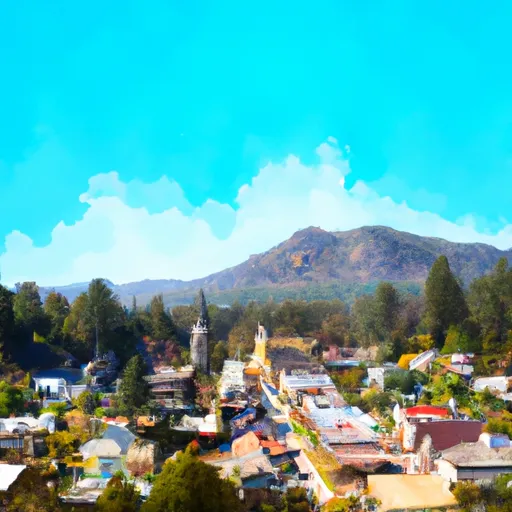-
 Snoflo Premium
Snoflo Premium
Get unlimited access to all our content
With no Ad interruptions! - Start Your Free Trial Login with existing account
Murphys
Eden Index
Climate
9.8
•
Recreation
7.5
•
Community
2.1
•
Safeguard
7.1/10

Murphys, California is a charming town located in Calaveras County, nestled in the Sierra Nevada foothills. The climate in Murphys is Mediterranean, characterized by hot, dry summers and mild, wet winters. Summers see average high temperatures in the 90s°F (32°C), while winters average in the 50s°F (10°C). The town receives about 30 inches of rainfall annually, mostly occurring from November to April.
Murphys is known for its pristine hydrology, with two major rivers nearby. The Stanislaus River runs through the area, providing excellent opportunities for fishing, kayaking, and canoeing. Additionally, the nearby New Melones Lake offers boating, water skiing, and swimming activities.
Outdoor recreation opportunities in Murphys are abundant. The area is surrounded by breathtaking natural beauty, making it perfect for hiking, biking, and camping. The scenic trails in the Calaveras Big Trees State Park offer a chance to explore ancient giant sequoias. Nearby lakes and rivers provide opportunities for picnicking, birdwatching, and wildlife spotting. Murphys is also home to several golf courses, offering golf enthusiasts a chance to enjoy their favorite sport amidst the picturesque landscapes.
In summary, Murphys, California offers a Mediterranean climate, picturesque hydrology, and diverse outdoor recreation opportunities, making it an ideal destination for nature lovers and outdoor enthusiasts.
What is the Eden Index?
The Snoflo Eden Index serves as a comprehensive rating system for regions, evaluating their desirability through a holistic assessment of climate health, outdoor recreation opportunities, and natural disaster risk, acknowledging the profound impact of these factors on livability and well-being.
Climate Health Indicator (CHI): 9.8
Murphys receives approximately
985mm of rain per year,
with humidity levels near 75%
and air temperatures averaging around
15°C.
Murphys has a plant hardyness factor of
9, meaning
plants and agriculture in this region tend to thrive here all year round.
By considering the ideal temperature range, reliable water supplies, clean air, and stable seasonal rain or snowpacks, the Climate Health Indicator (CHI) underscores the significance of a healthy climate as the foundation for quality living.
A healthy climate is paramount for ensuring a high quality of life and livability in a region, fostering both physical well-being and environmental harmony. This can be characterized by ideal temperatures, reliable access to water supplies, clean air, and consistent seasonal rain or snowpacks.
Weather Forecast
Streamflow Conditions
San Joaquin
Area Rivers
San Joaquin
Snowpack Depths
San Joaquin
Reservoir Storage Capacity
San Joaquin
Groundwater Levels
Recreational Opportunity Index (ROI): 7.5
The Recreational Opportunity Index (ROI) recognizes the value of outdoor recreational options, such as parks, hiking trails, camping sites, and fishing spots, while acknowledging that climate plays a pivotal role in ensuring the comfort and consistency of these experiences.
Access to outdoor recreational opportunities, encompassing activities such as parks, hiking, camping, and fishing, is crucial for overall well-being, and the climate plays a pivotal role in enabling and enhancing these experiences, ensuring that individuals can engage in nature-based activities comfortably and consistently.
Camping Areas
| Campground | Campsites | Reservations | Toilets | Showers | Elevation |
|---|---|---|---|---|---|
| Indian Grinding Rock State Park | 22 | 2,378 ft | |||
| Sugar Pine Point | 8 | 5,889 ft | |||
| Mokelumne River | 13 | 3,234 ft | |||
| Calaveras Big Trees State Park | 129 | 4,485 ft | |||
| Mokelumne | 13 | 3,240 ft | |||
| Pipi | 51 | 3,922 ft | |||
| Moore Creek | 8 | 3,297 ft | |||
| South Shore | 22 | 6,017 ft | |||
| Pardoes Point | 10 | 5,845 ft | |||
| Big Oak - Glory Hole Area - New Melones Lake | 55 | 1,050 ft |
Nearby Fishing
Nearby Ski Areas
Catastrophe Safeguard Index (CSI):
The Catastrophe Safeguard Index (CSI) recognizes that natural disaster risk, encompassing floods, fires, hurricanes, and tornadoes, can drastically affect safety and the overall appeal of an area.
The level of natural disaster risk in a region significantly affects safety and the overall livability, with climate change amplifying these risks by potentially increasing the frequency and intensity of events like floods, fires, hurricanes, and tornadoes, thereby posing substantial challenges to community resilience and well-being.
Community Resilience Indicator (CRI): 2.1
The Community Resilience Indicator (CRI) recognizes that education, healthcare, and socioeconomics are crucial to the well-being of a region. The CRI acknowledges the profound impact of these elements on residents' overall quality of life. By evaluating educational resources, healthcare accessibility, and economic inclusivity, the index captures the essential aspects that contribute to a thriving community, fostering resident satisfaction, equity, and social cohesion.

